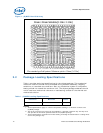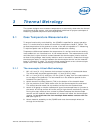
Reference Thermal Solution
20 Thermal and Mechanical Design Guidelines
Figure 5. Processor Heatsink Orientation to Provide Airflow to (G)MCH Heatsink on an
ATX Platform
Proc _HS_Orient_ATX
Airflow Direction
Airflow Direction
Airflow Direction
Airflow Direction
Airflow Direction
Airflow Direction
Airflow Direction
Airflow Direction
(G)MCH Heatsink
TOP VIEW
Omi Directional Flow
Processor Heatsink
(Fan Not Shown)
Other methods exist for providing airflow to the (G)MCH heatsink, including the use of
system fans and/or ducting, or the use of an attached fan (active heatsink).
4.1.2 Balanced Technology Extended (BTX) Form Factor
Operating Environment
The operating environment for the (G)MCH in typical BTX systems has not been
profiled. This section provides operating environment conditions based on what has
been exhibited on the Intel micro-BTX reference design. On a BTX platform, the
(G)MCH obtains in-line airflow directly from the processor thermal module. Since the
processor thermal module provides lower inlet temperature airflow to the processor,
reduced inlet ambient temperatures are also often seen at the (G)MCH as compared to
ATX. An example of how airflow is delivered to the (G)MCH on a BTX platform is
shown in
Figure 6.
The local ambient air temperature, T
A
, at the (G)MCH heatsink in the Intel micro-BTX
reference design is predicted to be ~45 °C. The thermal designer must carefully select
the location to measure airflow to get a representative sampling. These environmental
assumptions are based on a 35 °C system external temperature measured at sea
level.
Note: The local ambient air temperature is a projection based on anticipated power
increases on a 2005 platform and may be subject to change in future revisions of this
document.


















